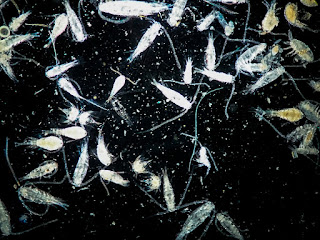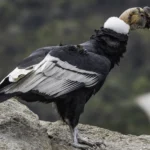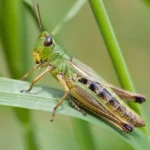
Zooplankton is a type of plankton made up of small, free-floating animals found in the oceans, seas, rivers, and ponds. Hundreds of thousands of different animal species are part of the zooplankton and are usually found near the surface of the water. , or rarely at 1,300 feet. The greatest threats to future zooplankton survival are climatic changes and the increase in ultraviolet radiation (as a result of the thinning of the ozone layer).
Most zooplankton are filter feeders, using their appendages to strain bacteria and algae and other fine particles in the water. Others are predators, feeding on smaller zooplankton.
Most animals that belong to the group of zooplankton are microscopically small, 0.01 to 0.16 inches long.
Zooplankton can reproduce rapidly, and populations can increase by about 30 percent a day under favorable conditions.
Even though easily visible by naked eye, jelly fish is also classified as zooplankton because it cannot actively swim against the current.
Zooplankton reach maturity quickly and live short, but productive lives. For example, adult females of a zooplankter called Daphnia can produce their body mass in eggs every two to three days. Daphnia live an average of one month.
Most types of zooplankton have transparent body (which aids in camouflage). Species of zooplankton that live in fishless ponds have brightly-colored, usually orange or blue body.
At the Savannah River Site, zooplankton are found in freshwater reservoirs, ponds and streams. They are abundant in Carolina bays, wetlands that often dry in the summer and fill with water in the fall.
Most animals that belong to the group of zooplankton have long antennas on top of the head and elongated, cylindrical or torpedo-shaped body covered with protective shell. Some species are legless, while others have few pairs of leafy legs and flagella and cilia on the body.
The total weight of zooplankton produced annually in Rainbow Bay, a Carolina bay on the Savannah River Site, is about twice the weight of the thousands of salamanders found there.
Name “zooplankton” originates from two Greek words: “zoon” which means “animal”, and “planktos” which means “drifter”. Name refers to the inability of these tiny animals to swim on their own.
Although food, temperature and water chemistry all are important in determining what kinds of zooplankton can live in a particular lake or pond, the most important factor is predators, particularly fish.
Adaptations such as flattened body, spines on the shell, low-density materials stored in the body, as well as movement of flagella and cilia prevent sinking of zooplankton.
Fish prefer to eat the larger and more visible kinds of zooplankton.
Zooplankton is dynamic community. Number of species and size of the population depend on the season.
Zooplankton that coexist with fish are typically small (less than 1 to 1.5 millimeters) and transparent.
Zooplankton consists of temporary members such as larvae of fish and crabs which live as zooplankton only during the larval stage, and various species of protozoa, mollusks, echinoderm, arthropods…which spend their entire life as free-floating organisms.
Zooplankton that live in ponds without fish, such as temporary ponds, often are much larger (up to 3 to 4 millimeters).
Zooplankton is mostly restricted to the upper parts of the water. Some species of animals spend day in deep water and migrate toward the surface at night.
Some kinds of zooplankton in fishless ponds are quite colorful: a variety called copepods can be bright orange, blue or blue with red antennae.
Diet of zooplankton is based on the algae and bacteria (phytoplankton) and tiny animals.
The very largest zooplankton, called fairy and clam shrimps, live only in fishless ponds.
Zooplankton is important source of food for fish, salamanders, aquatic insects and large marine animals such as whales.
On the Savannah River Site and throughout the Upper Coastal Plain, three varieties of freshwater zooplankton are most common. They are rotifers, cladocerans and copepods. Also, fairy and clam shrimps live in ponds that dry out seasonally.
Some species of zooplankton inhabit ponds that dry periodically. They spend dry periods of year in the mud, hidden inside protective cases.
Like phytoplankton, zooplankton are usually weak swimmers and usually just drift along with the currents.
Zooplankton reproduces quickly and rapidly increases population size. Under favorable conditions, population size can increase for 30% in 24 hours.
Along with phytoplankton, zooplankton are key components of marine ecosystems forming the base of most marine food webs.
Without environmental factors which keep reproduction of some species of zooplankton (such as Filinia) under control, the entire world would be covered with 3-feet-thick layer of zooplankton in 130 days.
Zooplankton also include the nanoplanktonic flagellates that help keep bacteria populations under control. They are characterized by either a long tail used for swimming (flagellates) or by hair-like structures called cilia (ciliates).
Lifespan of zooplankton depends on the species. Daphnia, for example, can survive up to 30 days.
Another type of zooplankton include the larvae of benthic mollusks usually found in coastal waters, such as marine gastropods including heteropods or pteropods.
Frequently Asked Questions About Zooplankton
Here are some frequently asked questions about zooplankton, along with detailed answers:
- What are zooplankton?
Zooplankton are tiny animals that drift or weakly swim in the water column of oceans, lakes, and ponds. They come in a wide range of sizes, from microscopic organisms just a few microns long to larger jellyfish reaching several centimeters. Zooplankton can include single-celled organisms like protozoans, multicellular animals like copepods and krill, and even the larval stages of larger creatures like fish and crabs.
- What do zooplankton eat?
Zooplankton play a vital role in the aquatic food web. They can be categorized based on their feeding habits:
- Herbivores: These zooplankton graze on phytoplankton, the microscopic algae that form the base of the food chain. Examples include copepods and rotifers.
- Carnivores: Some zooplankton are predators and feed on other zooplankton or small organisms. Examples include certain jellyfish larvae and copepods.
- Omnivores: These zooplankton consume both plant and animal matter. Daphnia, a type of freshwater zooplankton, is a well-known omnivore.
- What eats zooplankton?
Zooplankton are a crucial food source for many aquatic animals. They are consumed by:
- Fish: From tiny fish larvae to large adult fish, many rely on zooplankton for sustenance.
- Whales: Giant whales like baleen whales filter massive amounts of water to capture zooplankton.
- Seabirds: Birds like penguins and krill-eating shrimp dive to feed on zooplankton near the ocean surface.
- Other zooplankton: Larger zooplankton species may prey on smaller ones.
- How important are zooplankton?
Zooplankton are essential for healthy aquatic ecosystems for several reasons:
- Food web foundation: They form the base of the food chain, transferring energy produced by phytoplankton to higher trophic levels.
- Nutrient cycling: Zooplankton play a role in recycling nutrients in the water column, making them available for phytoplankton growth.
- Water quality indicator: The abundance and diversity of zooplankton can be an indicator of water quality. A healthy population suggests a clean environment.
- How do zooplankton move around?
Most zooplankton are weak swimmers and rely on currents to drift through the water column. Some species exhibit vertical migration patterns, moving to deeper water during the day and rising towards the surface at night. This behavior may help them avoid predators or optimize feeding opportunities.
- Are there different types of zooplankton?
Zooplankton can be classified in various ways, including:
- Size: Microplankton (less than 200 microns), mesoplankton (200 microns to 2 millimeters), and macroplankton (greater than 2 millimeters).
- Life cycle: Holoplankton spend their entire lives as plankton, while meroplankton are the larval stages of bottom-dwelling organisms.
Some common types of zooplankton include:
- Copepods: Tiny crustaceans with segmented bodies, the most abundant animal group in the ocean.
- Krill: Shrimp-like crustaceans that form massive swarms and are a vital food source for whales.
- Foraminifera: Single-celled organisms with calcium carbonate shells, important for marine sediment formation.
- Rotifers: Microscopic animals with a crown of cilia for feeding, found in freshwater and marine environments.
- What are some threats to zooplankton populations?
Zooplankton populations can be affected by various factors, including:
- Pollution: Pollutants like pesticides and fertilizers can harm zooplankton directly or indirectly by disrupting the food web.
- Ocean acidification: Increased CO2 absorption by the oceans can make the water more acidic, hindering the formation of calcium carbonate shells in some zooplankton.
- Climate change: Rising water temperatures can affect plankton distribution and disrupt food web dynamics.
By protecting water quality and mitigating the effects of climate change, we can help ensure the health and abundance of zooplankton populations in our oceans and freshwater ecosystems.










The writing in this post was really polished and professional. It’s clear that the author put a lot of effort into crafting each sentence and making sure the post was free of errors. Well-written blog posts are a pleasure to read, and this post definitely met that criteria.